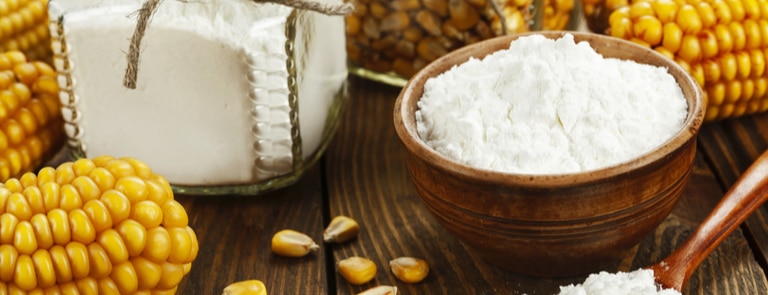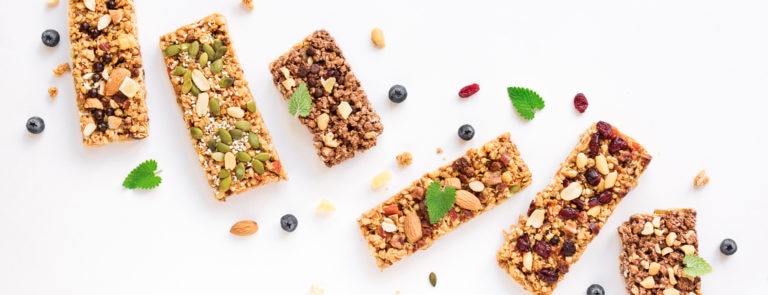15% off €25
Everything you need to know about cornflour

Corn starch or cornflour, maybe even maize starch if you live across the pond.
Whatever you know it as it’s a common ingredient that you’ll find in many foods and pantries as a culinary staple across the world.
In this article, we’re going to provide you with all you need to know about cornflour – what it is, where you can find it and any common alternatives.
But before we get into that, it’s only right that we clear up the UK meaning of cornflour. In the UK we call it cornflour, whereas in the US they call it corn starch.
Although, to confuse things, in the US they have something called cornflour which is what you might call cornmeal.
To put it simply: UK cornflour = US corn-starch and US cornflour = UK cornmeal.
For the sake of argument, and as we’re in the UK, we’ll be calling it cornflour in this article.
What is cornflour?
Cornflour is a finely powdered white starch which removed from corn kernels.1
It’s pretty much tasteless, but it’s used in cooking as a thickening agent for things like sauces and soups.
What is corn starch used for?
Cornflour is pretty much one of those staple kitchen items.
It has many uses from being used as a binding agent for puddings or cakes, or perhaps more commonly used to thicken soups, stews, sauces and other dishes.
How is cornflour made?
The process of making corn starch involves removing the protein and fibre of the corn kernel to leave behind the starchy centre, which is known as endosperm.
This is then refined into a white powder which we know to be cornflour. 2
Which foods is cornflour usually in?
It’s not necessarily that cornflour is found in foods, its more that it’s used as a binding or thickening agent.
BBC Food has a generous number of recipes that contain cornflour, from homemade custards, to cakes, cheesecakes and even “healthy” gravy.
So, realistically you may find it in supermarket bought foods, but generally it’s used as a staple of home cooking rather than appearing in foods.
Why do people avoid corn starch?
Despite its versatility, many people question cornflour because of its high calorie and carbohydrate content.
But it also lacks many nutrients like protein, fibre and other vitamins and minerals, which get removed in the production process.
Summary
- Cornflour is a staple for many kitchens, it helps thicken sauces, stews and soups as well as many other culinary delights.
- It doesn’t appear naturally in any food, but it is usually used as a thickening agent so it’s possible that you may find it as an ingredient in sauces etc.
- The downside to cornflour is its nutritional profile. Much of the fibre, protein and other vitamins are lost in the production process of cornflour – so it’s not really seen as favourable because of its seen as being high in carbohydrates.
Why is cornflour bad for you?
There is also thought that cornflour may affect your blood sugar levels. This is down to its high carb content, which means it has a high glycemic index (GI) – a rating system for food that measures how a specific food can affect your blood sugar levels.
Fibre is also an important nutrient that helps slow the absorption of sugar into your bloodstream.4
This means that your body digests corn starch very quickly, which may lead to spikes in your blood sugar levels. 5
So, for this reason, corn starch may not be a great addition to your diet, particularly if you are trying to manage your blood sugar levels or have type 2 diabetes.
Cornflour is also a refined carb, which means that because of its processing, it has been stripped of its nutrients.
Some studies show that if you regularly consume foods that are rich in refined carbs, such as corn starch, they can have a negative impact on your heart health.
One particular study found that refined carbs with a high GI may be linked to coronary heart disease, obesity and 2 diabetes. 6
What can be used instead of cornflour?
For the reasons mentioned above, you may want an alternative to cornflour.
It’s thought to be difficult to find an equal substitute, so its always worth checking what ratios you need to make it an even swap.
5 cornflour alternatives
- All-purpose flour
While all-purpose flour is not a gluten-free substitute, it is a great option when looking for a thickening agent. It works in very much the same as corn starch and may a great alternative.
- Rice flour
Rice flour is seen another great alternative to corn starch, however, it has a lighter consistency, so its perhaps better used for pan frying and deep frying for savoury dishes.
- Potato starch
Like rice flour, potato starch works as a substitute for savoury dishes like pan frying and sauces.
The advantage of potato starch is that you add at the end of making a sauce as it won’t separate, so you can thicken things up in no time.
- Arrowroot starch
Arrowroot starch is a great substitute for corn starch as it has the binding thickening agent powers as cornflour and it still applies that thick, glossy finish.
The only downside to arrowroot starch is that it doesn’t hold for long after being prepared, so it's perhaps a good idea to serve any sauces or gravies as soon as you can.
- Tapioca starch
Another great substitute is tapioca starch – a gluten free, tasteless flour like substance that derives from the cassava root.
It works very much the same way as corn starch as its good for thickening sauces, baked goods and pan-frying. It’s a pretty good all-rounder.
Summary
- Studies show that cornflour has been known to increase blood sugar levels and may even affect your heart – however, in the right amounts and if you’re eating a healthy, well balanced diet then you should have too many problems.
- Although, if you have type 2 diabetes or following a low-carb diet, there are some great alternatives on the market.
You also asked...
In the UK, corn starch is known as cornflour.
It’s only really in the UK and Australia that it’s referred to as cornflour, but that’s what its known as in shops and supermarkets over here.
It can be confusing, but in the US corn is referred to as maize is some areas. This is because maíz is a Spanish word meaning corn, and some areas use that pronunciation instead of corn.
So, when you hear maize starch it’s the same as corn starch in the US, or cornflour in the UK.
So, corn starch, maize starch, cornflour or whatever you prefer to call it, is gluten free.
The downsides to cornflour have been highlighted, but its fair to say that if you are eating a well-balanced, healthy diet, then small amounts in your sauces, stews or cakes can be enjoyed where you wish.
However, if you have diabetes or you are following a low carb diet, you may want to monitor how much corn starch you’re having in your diet.
Ideally you can swap this out for one of the alternatives such as:
- Arrowroot flour
- Potato starch
- Tapioca flour
Also, while cornflour is naturally gluten-free, you should also look on packaging to make sure that it’s a certified gluten-free variety. Particularly if you are sensitive to gluten or have celiac disease.
Corn allergies or allergies to corn products can vary. For many there will be no reaction at all, but for some it can be uncomfortable, and in some more severe cases the reaction may be more serious.
Usually, if you have an allergic reaction you will know from the first couple of minutes to two hours after consuming corn or any corn products.
Symptoms typically include:
- A tingling or itchy feeling in the mouth
- Hives or rashes
- Headaches
- Swollen lips, tongue, throat, face or other parts of the body
- Difficulty breathing, wheezing or nasal congestion
- Feeling dizzy, lightheaded or fainting
- nausea, vomiting, or diarrhoea
In severe cases, food allergies may result in anaphylactic shock. This is normally rare with allergies to corn. However, symptoms may include:
- Loss of consciousness
- Fast and irregular pulse
- Feelings of shock
- Difficulty breathing due to swelling of the throat and air passages
Summary of cornflour
Cornflour may go by a few different names depending on where you live.
But whatever you call it, it’s a fine, white powder made from the starchy bit of the corn kernel.
Cornflour is a staple of many kitchens throughout the world. Its main use being its versatility as a thickening agent in many sauces, soups and stews.
However, there are some downsides when it comes to nutritional profile, and you should really look for an alternative if you have diabetes or you are eating a low carb diet.
With that said, you can still eat cornflour as part of a healthy diet if used in moderation.
If you have any health concerns, then you should always speak to a health professional.
The advice in this article is for information only and should not replace medical care. Please check with your GP or healthcare professional before trying any supplements, treatments or remedies. Food supplements must not be used as a substitute for a varied and balanced diet and a healthy lifestyle.
Last updated: 22 February 2022
- https://www.bbc.co.uk/food/cornflour
- https://www.ncbi.nlm.nih.gov/pmc/articles/PMC4260129/
- https://www.fitbit.com/foods/Corn+Flour/537181881
- https://fdc.nal.usda.gov/fdc-app.html#/food-details/169698/nutrients
- https://www.ncbi.nlm.nih.gov/pmc/articles/PMC3257631/
- https://www.ncbi.nlm.nih.gov/pmc/articles/PMC6959586/



